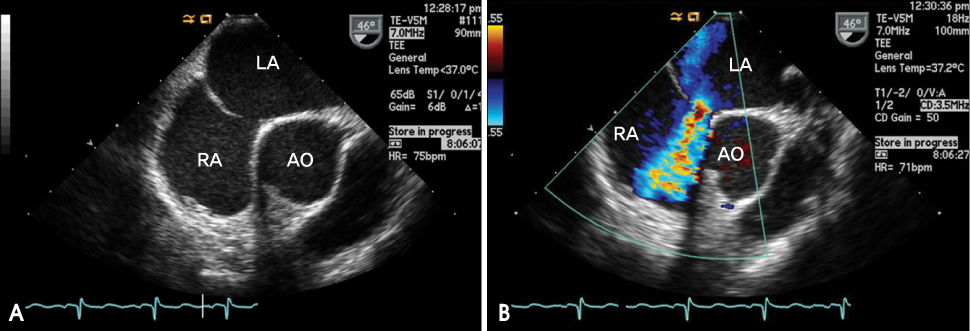J Cardiovasc Ultrasound.
2008 Mar;16(1):23-25. 10.4250/jcu.2008.16.1.23.
A Case of Successful Transcatheter Device Closure of Small Atrial Septal Defect in a Patient with Cerebral Infarction Presumably Caused by Paradoxical Emboli
- Affiliations
-
- 1The Heart Center of Chonnam National University Hospital, Chonnam National University Research Institute of Medical Sciences, Gwangju, Korea. jcpark54@hanmail.net
- KMID: 1486606
- DOI: http://doi.org/10.4250/jcu.2008.16.1.23
Abstract
- Precutaneous transcatheter device closure of interatrial communications is used as an alternative to surgery or long-term anticoagulation for the treatment of patients with paradoxical cerebral embolism. We report a case of successful percutaneous transcatheter closure of small atrial septal defect in a 34 year old female patient with acute cerebral infarction presumably caused by paradoxical embolism through the defect.
Keyword
MeSH Terms
Figure
Reference
-
1. Mohr JP. Cryptogenic stroke. N Engl J Med. 1988. 318:1197–1198.
Article2. Gazzaniga AB, Dalen JE. Paradoxical embolism: Its pathophysiology and clinical recognition. Ann Surg. 1970. 171:137–142.3. Wu LA, Malouf JF, Dearani JA, Hagler DJ, Reeder GS, Petty GW, Khandheria BK. Patent foramen ovale in cryptogenic stroke. Arch Intern Med. 2004. 164:950–956.
Article4. Muller L, Dillon T, Beekman RH. Myocardial ischemia: Atypical presentation of an atrial septal defect in childhood. J Interv Cardiol. 2005. 18:397–399.
Article5. Bartz PJ, Cetta F, Cabalka AK, Reeder GS, Squarcia U, Agnetti A, Aurier E, Carano N, Tachana B, Hagler DJ. Paradoxical emboli in children and young adults: Role of atrial septal defect and patent foramen ovale device closure. Mayo Clin Proc. 2006. 81:615–618.
Article6. Windecker S, Wahl A, Chatterjee T, Garachemani A, Eberli FR, Seiler C, Meier B. Percutaneous closure of patent foramen ovale in patients with paradoxical embolism: Long-term risk of recurrent thromboembolic events. Circulation. 2000. 101:893–898.
Article7. Hung J, Landzberg MJ, Jenkins KJ, King MEE, Lock JE, Palacios IF, Lang P. Closure of patent foramen ovale for paradoxical emboli: Intermediate-term risk of recurrent neurological events following transcatheter device placement. J Am Coll Cardiol. 2000. 35:1311–1316.
Article8. Bruch L, Parsi A, Grad MO, Rux S, Burmeister T, Krebs H, Kleber FX. Transcatheter closure of interatrial communications for secondary prevention of paradoxical embolism: Single-center experience. Circulation. 2002. 105:2845–2848.
Article9. Khairy P, O'Donnell CP, Landzberg MD. Transcatheter closure versus medical therapy of patent foramen ovale and presumed paradoxical thromemboli: A systematic review. Ann Intern Med. 2003. 139:753–760.
Article10. Harms V, Reisman M, Fuller CJ, Spencer MP, Oslen JV, Krabill KA, Gray WA, Jesurum JT. Outcomes after transcatheter closure of patent foramen ovale in patients with paradoxical embolism. Am J Cardiol. 2007. 99:1312–1315.
Article11. Homma S, DiTullo MR, Sacco RL, Smith C, Mohr JP. Surgical closure of patent foramen ovale in cryptogenic stroke patients. Stroke. 1997. 28:2376–2381.
Article12. Nandaz M, Sarasin F, Bogousslavsky J. How to prevent stroke recurrence in patients with patent foramen ovale: anticoagulants, antiaggregants, foramen closure, or nothing? Eur J Neurol. 1997. 37:199–204.
Article
- Full Text Links
- Actions
-
Cited
- CITED
-
- Close
- Share
- Similar articles
-
- Comprehensive understanding of atrial septal defects by imaging studies for successful transcatheter closure
- Transcatheter Closure of Atrial Septal Defect: Does Age Matter?
- Subacute, Silent Embolization of Amplatzer Atrial Septal Defect Closure Device to the Pulmonary Artery
- Outcome of Transcatheter Closure of Oval Shaped Atrial Septal Defect with Amplatzer Septal Occluder
- Emergent Surgical Intervention for Embolization of Atrial Septal Defect Closure Device





